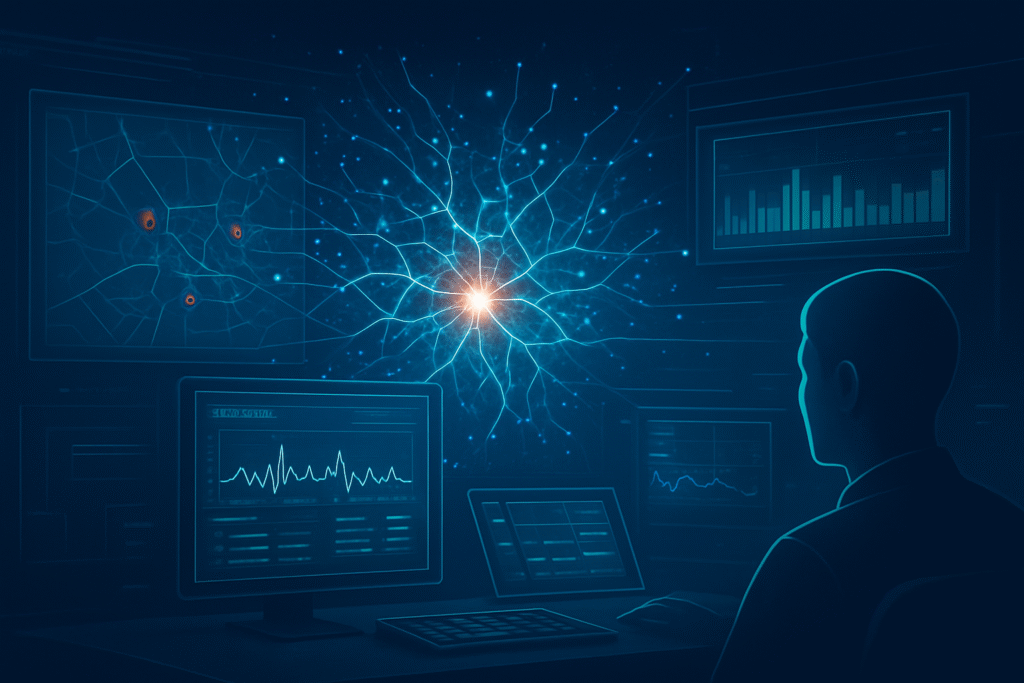
Spokane, WA – November 18, 2025 – In a significant stride towards modernizing public safety, Spokane Regional Emergency Communications (SREC) is in the advanced stages of implementing a sophisticated artificial intelligence (AI) enhanced system designed to streamline the handling of non-emergency calls and bolster overall emergency response capabilities. The initiative, centered around Hexagon’s HxGN OnCall solutions, aims to address increasing call volumes, optimize dispatcher efficiency, and foster greater collaboration across 21 first responder agencies in Spokane County. While the full system is slated to go live by Spring 2026, its anticipated impact is already generating considerable discussion within the public safety and technology sectors.
This strategic technological upgrade is poised to transform how SREC manages its substantial annual volume of non-emergency inquiries, often referred to as "Crime Check" calls. By leveraging AI for initial triage, data analysis, and intelligent routing, SREC expects to free up human telecommunicators to focus on critical, life-threatening emergencies, ultimately leading to faster and more accurate responses for the county's 550,000 residents. However, a parallel development sees the City of Spokane moving forward with its own independent dispatch system, raising questions about regional interoperability and coordination as both systems prepare for their respective launches.
Hexagon's HxGN OnCall Solutions: A Deep Dive into AI-Powered Dispatch
SREC's new system is built upon Hexagon’s (NASDAQ: HEXA B) HxGN OnCall solutions, a comprehensive public safety platform that integrates cutting-edge AI and machine learning capabilities into its core Computer-Aided Dispatch (CAD) functionalities. Central to this advancement is HxGN OnCall Dispatch | Smart Advisor, an assistive AI tool that significantly enhances real-time incident recognition and decision support.
The Smart Advisor component continuously scans incident reports and call data logged by 911 call-takers. Utilizing advanced statistics, machine learning, and AI, it actively looks for keywords, similarities, recurring locations, statistical anomalies, and even weather patterns that human operators might overlook, especially during peak call volumes. When patterns or links are identified, the system proactively generates informational alerts and often suggests recommended actions directly on the call-taker's screen. This capability helps dispatchers connect seemingly unrelated events, enabling more informed decisions and strategic deployment of personnel and resources. The system also supports next-generation 911 (NG911/112) communications, offering flexible deployment options.
This approach marks a significant departure from traditional, predominantly manual dispatch systems. Older systems often rely on human operators to sift through information, assess situations, and deploy resources reactively. HxGN OnCall's AI-driven platform shifts this paradigm by providing real-time operational intelligence, augmenting human decision-making rather than replacing it. It streamlines workflows, improves situational awareness, and aims to reduce errors by automating routine data analysis and highlighting critical insights. While SREC's previous system included an "automatic aid" feature for dispatching, the Hexagon platform offers a far more integrated and intelligent layer of assistance. Initial reactions from industry experts generally praise such AI-enhanced dispatch systems for their potential to improve efficiency, accuracy, and resource management, especially in addressing dispatcher staffing shortages and burnout. However, concerns about algorithmic bias, cybersecurity risks, and the critical need for human oversight are consistently highlighted as paramount considerations.
AI in Emergency Dispatch: Reshaping the Tech Industry Landscape
The widespread adoption of AI in emergency dispatch, as seen with SREC's Hexagon implementation, is creating a dynamic shift across the tech industry, benefiting specialized AI companies, influencing tech giants, and fostering innovation among startups.
Companies like Hexagon (NASDAQ: HEXA B), a long-standing player in public safety software, are clear beneficiaries, leveraging their domain expertise to integrate advanced AI into their comprehensive platforms. This allows them to maintain and expand their market leadership by offering robust, AI-enhanced solutions that address critical public sector needs. Beyond established players, a vibrant ecosystem of startups is emerging. Companies like Hyper and Aurelian are deploying AI-powered voice agents to automate non-emergency calls, while Prepared offers an AI and cloud-based platform for 911 centers, providing real-time translation and advanced speech processing. RapidDeploy, recently acquired by Motorola Solutions (NYSE: MSI), exemplifies how larger tech firms are strategically integrating cutting-edge AI capabilities to secure their market position and expand their public safety portfolios.
Tech giants, while not always directly building dispatch systems, play a crucial foundational role. Cloud providers such as Microsoft Azure (NASDAQ: MSFT) and Amazon Web Services (NASDAQ: AMZN) are essential, offering the secure, scalable infrastructure required for these advanced systems. Their general-purpose AI research in natural language processing (NLP) and machine learning also forms the bedrock for many specialized public safety AI applications. The competitive landscape for major AI labs centers on the demand for their general-purpose AI models to be specialized for high-stakes public safety contexts, creating opportunities for partnerships and licensing. This also places a heightened emphasis on ethical AI development to mitigate biases and ensure accountability. The disruption to existing products is significant; legacy CAD systems lacking AI integration risk becoming obsolete, and manual processes are being replaced by automated triage and real-time data analysis. Companies are positioning themselves through specialization, offering full-stack platforms, adopting cloud-native SaaS models, and emphasizing seamless integration with existing infrastructure, all while addressing ethical concerns and demonstrating tangible results.
Wider Significance: AI's Role in a Safer Society
The integration of AI into emergency dispatch, as demonstrated by SREC's move, represents a pivotal moment in the broader AI landscape, signaling a deeper penetration of advanced intelligence into critical public services. This trend aligns with the wider movement towards "assistive AI," where technology enhances human capabilities rather than replacing them, acting as a force multiplier in often understaffed and high-pressure environments.
Operationally, the impacts are profound: faster response times due to quicker call processing and resource allocation, reduced dispatcher workload alleviating burnout, and improved language translation enhancing accessibility for diverse communities. AI provides real-time situational awareness by fusing data from various sources, allowing for more informed decision-making and better inter-agency coordination. For example, AI can identify life-threatening conditions like cardiac arrest within the first minute of a call more accurately than humans, potentially saving lives. Societally, this promises a more efficient and responsive public safety infrastructure. However, these advancements come with significant concerns. Ethical dilemmas surrounding algorithmic bias, particularly in predictive policing or caller sentiment analysis, are paramount. If AI models are trained on biased data, they could inadvertently lead to discriminatory outcomes. Privacy and data protection are also critical, as these systems handle highly sensitive personal information, necessitating robust cybersecurity and transparent data practices. While AI is primarily seen as an assistive tool to address staffing shortages, concerns about job displacement for human dispatchers persist, underscoring the need for clear communication and workforce adaptation strategies.
Comparing this to previous AI milestones, the current wave in emergency dispatch moves beyond earlier rule-based systems to sophisticated machine learning that can learn, adapt, and provide real-time cognitive assistance. It represents a shift from static data analysis to dynamic, multimodal data fusion, integrating voice, text, location, and sensor data for a comprehensive operational picture. Unlike some AI applications that aim for full automation, the emphasis here is on human-AI collaboration, recognizing the irreplaceable human elements of empathy, judgment, and adaptability in crisis situations. The direct impact on public safety and human lives elevates the importance of ethical considerations and robust governance frameworks, as reflected in regulations like the EU's AI Act, which classifies AI in emergency calls as "high-risk."
The Horizon: Future Developments in Emergency AI
The future of AI in emergency dispatch, building on foundational implementations like SREC's Hexagon system, is poised for continuous and transformative advancements, moving towards more integrated, proactive, and intelligently assisted public safety ecosystems.
In the near term (1-3 years), we can expect significant enhancements in AI-powered call insights and transcription, with systems automatically flagging critical details and reducing dispatcher workload. Automated call triage and routing will become more sophisticated, efficiently distinguishing between emergency and non-emergency calls and directing them appropriately. Real-time language translation will become standard, breaking down communication barriers. Furthermore, AI will enhance predictive analytics, leveraging diverse data streams to anticipate potential emergencies and proactively allocate resources. Experts also foresee AI playing a greater role in dispatcher training through realistic simulations and in quality assurance by reviewing a significantly higher percentage of calls for compliance and improvement.
Looking further ahead (3-10+ years), emergency dispatch systems will evolve into highly integrated platforms that fuse vast amounts of data from smart city sensors, drones, body cameras, and IoT devices, creating a holistic "common operating picture." This will enable proactive threat detection and prevention, moving beyond reactive responses to anticipating and potentially preventing incidents. Advanced AI algorithms will dynamically optimize resource allocation across multiple agencies, leading to near-autonomous recommendations for deploying the most appropriate units. New applications could include AI for mental health triage, automated first aid instructions based on caller descriptions, and video analysis for rapid damage assessment and survivor location during mass incidents. The challenges to address include ensuring AI accuracy and reliability in high-stakes situations, safeguarding data privacy and security, mitigating algorithmic bias through diverse training data and audits, integrating with legacy systems, securing adequate funding, and building public trust through transparency and education. Experts universally predict that AI will remain an assistive technology, augmenting human capabilities to manage complex, emotionally charged incidents, while continuously improving its ability to handle routine tasks and provide critical insights.
A New Era for Emergency Communications
Spokane Regional Emergency Communications' adoption of Hexagon’s AI-enhanced system marks a significant inflection point in the evolution of public safety. This move, while still in its implementation phase with a Spring 2026 go-live date, underscores a broader trend towards leveraging intelligent automation to address the escalating demands on emergency services. The key takeaways are clear: AI promises enhanced efficiency, faster response times, and improved resource allocation, ultimately contributing to a safer community. However, the path forward necessitates careful navigation of ethical considerations, robust data security protocols, and strategic workforce adaptation.
The parallel development of the City of Spokane's independent dispatch system, "Spokane United 911," introduces a critical element of complexity, potentially impacting regional interoperability and coordination. This dynamic will be crucial to watch in the coming months as both entities work towards their respective operational dates in early 2026. The success of SREC's AI integration will not only serve as a benchmark for other emergency communication centers nationwide but also highlight the delicate balance between technological advancement and seamless inter-agency collaboration. The coming weeks and months will be vital in observing the final preparations, initial rollout, and the real-world impact of these transformative systems on public service efficiency and community safety.
This content is intended for informational purposes only and represents analysis of current AI developments.
TokenRing AI delivers enterprise-grade solutions for multi-agent AI workflow orchestration, AI-powered development tools, and seamless remote collaboration platforms.
For more information, visit https://www.tokenring.ai/.






